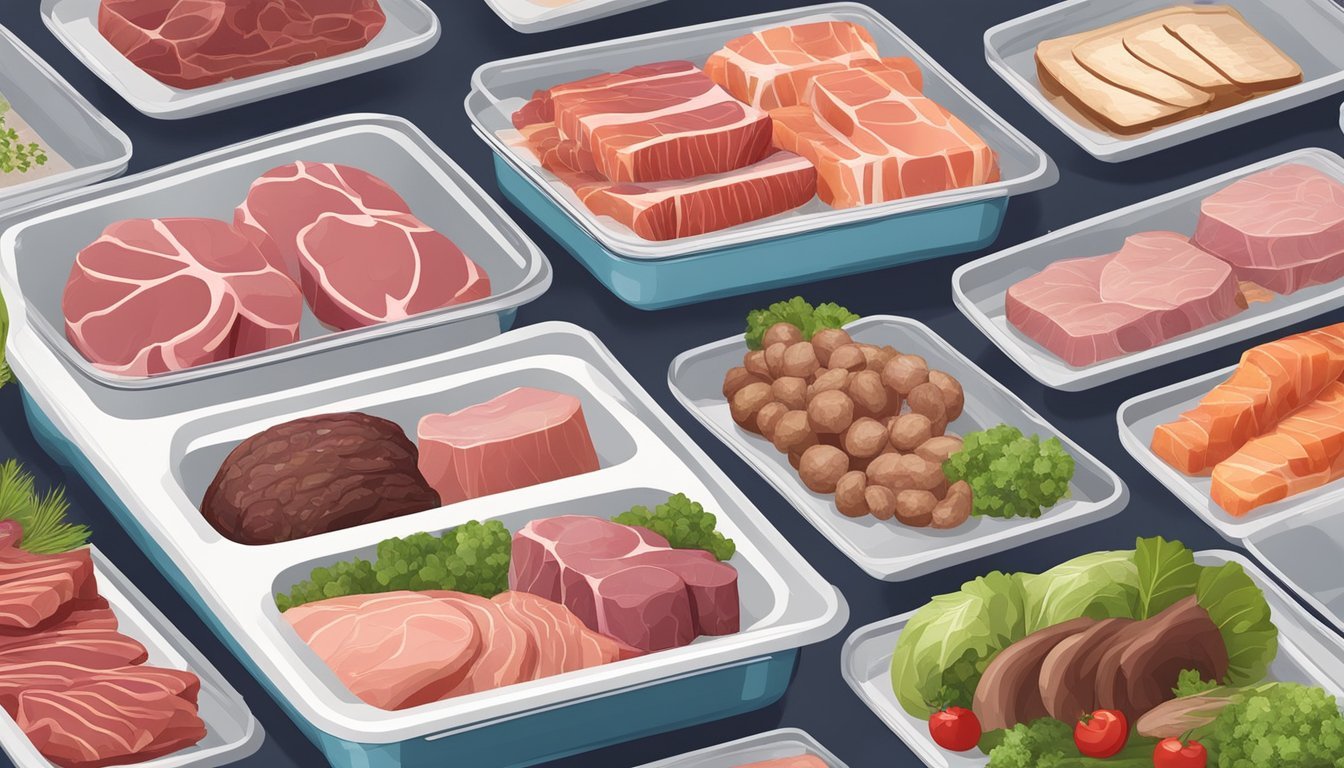Carnivore Diet on the Go
Quick Tips for Busy Meat-Eaters
This Article is Part Of Our Guide on the Carnivore Diet
Maintaining a carnivore diet requires commitment, particularly for individuals who are often on the move. This diet centers around animal-based foods, prioritizing the consumption of meats, seafood, eggs, and, in some cases, dairy products. Convenience and simplicity are the hallmarks, with the goal of sustaining high energy levels and satiety through nutrient-dense foods. For those with busy lifestyles, finding portable and shelf-stable carnivorous meals that adhere to the diet's guidelines can be challenging.
To address this, there are creative and practical solutions for carnivore diet enthusiasts. One can opt for highly portable food items such as beef jerky (how long does beef jerky last?), which is not only rich in protein and easy to consume on the go, but also requires no refrigeration. Additionally, incorporating foods like pre-cooked chicken strips or pork cracklings can add variety and satisfy cravings without straying from the diet's principles. This approach to meal preparation ensures that one can maintain the dietary regimen, no matter the location or schedule constraints.
Understanding the Carnivore Diet
The Carnivore Diet consists primarily of animal products, focusing on high protein and fat intake, and excludes plant-based foods.
Core Principles
The fundamental premise of the Carnivore Diet is that human beings should consume only animal products—meat, fish, eggs, and limited dairy. It operates on the philosophy that these foods provide all the necessary nutrients such as vitamins and minerals for health. Protein and fat are the cornerstones of the diet, with an emphasis on sourcing from a variety of animal products to maintain nutritional balance.
Health Benefits and Risks
Advocates of the Carnivore Diet suggest it may reduce inflammation and aid in the management of chronic diseases like autoimmune conditions. However, concerns arise due to high levels of saturated fat and cholesterol intake which are traditionally linked to an increased risk of heart disease and cancer. The diet's nutritional completeness is also under scrutiny by health professionals, insisting on diverse food sources for balanced health. Relatively little research has been conducted on the long-term health impacts of this diet.
Comparison with Keto and Paleo Diets
The Carnivore Diet is often compared to the Keto and Paleo diets due to their emphasis on low-carb eating and high animal products.
Keto Diet: Aims for a high-fat, moderate-protein, and low-carbohydrate intake. It encourages the body to enter a state of ketosis.
Paleo Diet: Focuses on eating whole, unprocessed foods that would have been available to Paleolithic humans. Incorporates fruits and vegetables, unlike the Carnivore Diet.
Both diets, unlike the Carnivore Diet, include plant-derived foods, which contribute beneficial fiber and a broader range of vitamins and minerals.
Meal Structuring for Carnivore Diet
Structuring meals for the carnivore diet centers around selecting from a variety of animal products, ensuring adequate fat intake, and prioritizing nutrient-dense organ meats. The goal is to maintain energy levels, satisfy hunger, and supply essential nutrients through a well-planned eating schedule.
Developing a Meal Plan
When developing a meal plan, individuals should focus on including a range of meats to prevent monotony and ensure a balanced intake of nutrients. A typical day might look like this:
Breakfast: Scrambled eggs with cheese
Lunch: Grilled chicken breast (What wine goes well with chicken breast?) and beef jerky
Dinner: Ribeye steak (What wine goes well with ribeye steak?) with a side of pork belly (What wine goes well with pork belly?) slices
Snacks: Hard-boiled eggs or slices of liverwurst
A meal plan should adequately balance fat and protein to meet energy needs, making note that fattier cuts may be more satiating. Consistency in meal timing can assist with digestion and energy levels throughout the day.
Importance of Organ Meat
Organ meats such as liver, heart, and kidney are foundational in the carnivore diet due to their high concentration of vitamins and minerals. They should be incorporated regularly. Here's an example of how to include organ meats:
Liver: Twice a week, have pan-seared liver as a main protein source.
Heart: Make beef heart stew or grill slices for a unique twist on steak.
Kidney: Prepare kidney pie or sauté kidney with onions for a flavor-packed meal.
Regular consumption of organ meats ensures a robust intake of essential nutrients like vitamin A, B vitamins (especially B12), iron, and CoQ10, supporting overall health.
Incorporating Seafood
Seafood presents a diverse and nutrient-rich option for those on a carnivore diet. Fatty fish, such as salmon and mackerel, are an excellent source of omega-3 fatty acids and vitamins like D and B12, making them a valuable addition to a carnivore diet meal plan. A practical application can be:
Lunch: A can of sardines (how long do sardines last?) or smoked salmon as an on-the-go option.
Dinner: Grilled mackerel or baked trout as the main dish.
Including a variety of seafood not only adds culinary diversity but also enhances the diet's nutritional profile with vital proteins, fats, and micronutrients.
Carnivore Diet On the Go
Adhering to a carnivore diet when away from home becomes seamless with strategic meal planning and a selection of zero-carb, high-protein foods. This section guides you through choosing portable snacks, making informed choices while dining out, and managing your dietary needs during travel.
Convenient Carnivore Snacks
For those following a carnivore diet, snacks are best kept simple and rich in protein. Some reliable options that require minimal to no preparation include:
Beef jerky: Opt for varieties without added sugars or preservatives.
Pork rinds: These are a crispy, satisfying option with zero carbs.
Boiled eggs: Easy to prepare in advance; they offer high-quality protein and fats.
Cheese: A variety of hard cheeses can be a good source of fat and protein.
Pork belly: Cook ahead and enjoy cold slices on the go.
These snacks provide the convenience and energy needed to maintain the diet outside the home.
Dining Out Strategies
Eating out does not have to derail your carnivore diet. Consider the following approaches:
Request simple foods: Ask for grilled meats like steaks (preferably grass-fed beef), lamb chops (What wine goes well with lamb chops?), or pork chops (What wine goes well with pork chops?) without added sauces or marinades.
Customize your order: Most restaurants can accommodate a simple butter or cream sauce upon request.
State your dietary restrictions clearly to the staff to avoid hidden carbs.
By focusing on meat-based dishes and communicating your needs, dining out can align with your carnivore lifestyle.
Travel Tips
Managing a carnivore diet while traveling requires forward-thinking:
Pack snacks: Bring a selection of the snacks mentioned above to have ready access to compliant foods.
Source locally: Look for supermarkets or delis that sell hard-boiled eggs, cheese, and dairy products on arrival.
Portable bone broth: Some brands offer bone broth in powder form, which can be mixed with hot water.
Consider intermittent fasting to simplify your eating schedule on travel days.
Through preparation and adaptability, maintaining a carnivore diet on the go is entirely feasible.
Nutritional Considerations
When adopting a carnivore diet on the go, one must be vigilant about maintaining a balanced intake of macronutrients and addressing the potential scarcity of certain micronutrients typically sourced from plant-based foods. Ensuring adequate hydration is also essential.
Managing Macronutrients
Protein: A central component of the carnivore diet, protein is readily available in meats and seafood. Consumers should opt for a mix of lean and fatty meats to balance their protein intake with fat.
Lean meats: chicken breast, turkey, lean beef cuts
Fatty meats: ribeye steak, lamb, pork
Fat: While fat is a crucial energy source on this diet, attention should be given to the types of fats consumed, emphasizing a balance between saturated and unsaturated fats.
Saturated fats: found in butter and fatty cuts of meat
Unsaturated fats: accessible in foods like fish and eggs
One should limit:
Carbs: inherently low on the carnivore diet
Sugar: avoid processed meats high in added sugars
Addressing Micronutrient Needs
Micronutrients can be a concern in a diet devoid of fruits and vegetables. Here's what to look for:
Vitamin C: Typically found in citrus, but adequate amounts can be obtained from organ meats.
Fiber: While absent in animal products, a zero-carb diet may not necessitate fiber for digestive health.
Micronutrients: Liver and other organ meats are dense in nutrients and can provide a broad spectrum of vitamins and minerals.
Sodium: Present in most meats, but those on the go should watch for excessive intake, especially from cured or processed meats.
Antioxidants: Although more commonly associated with plant foods, some animal products like bone broth may offer antioxidant benefits.
Staying Hydrated on Carnivore Diet
Water intake is crucial, especially since the carnivore diet is high in protein and can increase fluid needs.
Adults should aim for approximately 2.7 to 3.7 liters of water per day, though individual needs can vary.
One can monitor hydration via urine color, aiming for light yellow.
This section underscores the importance of cautious planning to meet all nutritional needs while maintaining the constraints of the carnivore diet, especially when on the move.
Adapting to a Carnivorous Lifestyle
Adopting a carnivorous diet means substantial changes in food choices and social interactions. It involves a focus on meats, fats, and other animal products, while excluding vegetables, grains, and fruits. This section will guide readers through the nuances of integrating the carnivore diet into various aspects of their daily life.
Dealing with Social Situations
When committing to a carnivore lifestyle, social settings may present a challenge. It requires clear communication and assertiveness to navigate food choices that align with one's dietary restrictions. For social gatherings:
Politely decline plant-based offerings and opt for meat or dairy items.
Suggest restaurants with carnivore-friendly menus, emphasizing steak or seafood options.
In addition, one could:
Offer to bring a dish to share, ensuring there is at least one carnivore-compliant option available.
Engage in discussions about dietary choices with respect but without the need to justify personal health decisions.
Combining Carnivore with Fitness Routines
Incorporating fitness routines while adapting to a carnivorous diet involves ensuring that energy needs are met for optimal performance and weight loss. Individuals may focus on:
Consuming adequate protein to support muscle repair and growth.
Adjusting fat intake for energy needs, particularly when engaging in high-intensity or endurance exercises.
Fitness enthusiasts should monitor their body's response during exercise and may require a period of adjustment. Advocates like Dr. Shawn Baker emphasize that an all-meat diet can cater to athletic performance after this adaptation phase.
Mindful Eating
Mindful eating on a carnivore diet involves being attuned to one’s body's hunger and satiety signals. One should prioritize:
Eating when truly hungry, choosing satiating foods high in fats and proteins.
Listening to the body’s response to different animal products and adjusting accordingly.
For those with specific health issues, mindful eating can help in identifying foods that contribute to or alleviate symptoms. It is essential for individuals to pay close attention to how their fat mass and overall health respond to a diet devoid of plant-based foods.
Challenges and Solutions
Adopting a carnivore diet can present its own set of challenges, particularly when one is on the go. This section explores practical strategies to manage carb cravings and digestive changes.
Managing Cravings for Carbs and Sugars
When individuals embark on a carnivore diet, they often face intense cravings for carbohydrates and sugars, as their intake of these is drastically reduced or eliminated. Solutions include:
Select High-Fat Meats: They tend to feel more satiating, which can help reduce cravings for high-carb foods. For example, one might opt for a ribeye steak over a leaner cut of meat.
Incorporate Animal Products with Natural Fats: Items like eggs and certain full-fat dairy products can also help keep cravings at bay.
Addressing Digestive Adjustments
A dramatic shift in dietary content can lead to digestive adjustments, with some individuals experiencing initial discomfort when eliminating fiber and plant-based foods.
Key solutions are:
Start with Easily Digestible Meats: Beginning with meats that are easier on the digestive system, such as chicken or fish, can help during the transition period.
Include Natural Digestive Aids: Bone broth is rich in nutrients and can support digestive health. Similarly, if dairy is tolerated, small amounts of high-quality dairy could aid digestion without introducing carbohydrates or sugars.
Food Preparation and Recipes
Preparing meals for the carnivore diet while on the go can be straightforward with the right recipes and a focus on sustainable practices. This section provides specific approaches for quick recipe preparation and ideas to ensure the diet is sustainable even when busy.
Quick and Easy Carnivore Recipes
For individuals looking for high-protein, no-carb meals, there are various recipes that can be quickly assembled. Consider these options:
Beef Jerky: Ideal for snacking, beef jerky is a portable and convenient option, with a focus on versions without added sugars or preservatives.
Stacked Carnivore Burgers: Use patties of grass-fed beef with slices of bacon in between, and serve with a side of fried eggs.
Carnivore Chili: Brown some ground beef and simmer with bone broth and organ meat for a rich, nutrient-dense meal.
Seafood lovers can enjoy the simplicity and quick preparation of:
Grilled Salmon or Tuna Steaks (What wine goes well with tuna steak?): Season these fatty fish with salt and pepper and grill for a few minutes on each side.
Sautéed Shrimp or Scallops: Just a few minutes in a hot pan with animal fat, and these seafood options offer a quick, delicious meal.
Making Carnivore Diet Sustainable
Sustainability on the carnivore diet means selecting the right foods and preparing them to reduce waste and maintain nutritional value. Here is how one can make the carnivore diet sustainable:
Choose local and responsibly sourced meats and seafood to limit environmental impact.
Utilize the whole animal, including organ meats and bone marrow, to minimize waste and maximize nutritional intake.
Consider preparing larger portions of meat, like a roast or leg of lamb, which can be eaten throughout the week.
Store prepared foods properly to prolong shelf life, making it easier to adhere to the diet even with a busy schedule.
By incorporating these easy recipes and focusing on sustainability, adherents of the carnivore diet can easily maintain their dietary preferences on the go.
Beyond Diet: Lifestyle Consideration
When adopting a carnivore diet for convenience, individuals must also weigh the broader implications such as environmental impact and ethical concerns associated with increased consumption of animal products.
Impact on Environmental Sustainability
The carnivore diet's emphasis on animal products raises questions about sustainability. Animal farming is resource-intensive, often requiring more land, water, and feed compared to plant-based agriculture. Consequently, such a diet may contribute to larger environmental footprints. In contrast, diets like keto or paleo may incorporate more plant-based elements which can potentially lessen ecological impact. Research indicates that processed meats, often convenient for on-the-go carnivore options, can come with added environmental costs due to their production processes.
Ethical Considerations of a Carnivore Diet
Ethically, a carnivore diet relies heavily on meat consumption, thus one should consider animal welfare in their dietary choices. The diet's exclusivity to animal products may contrast with ethical positions that favor reducing meat consumption. Consumers are encouraged to seek out sources that adhere to humane treatment standards. Health-wise, while there are individual reports of benefits, it’s crucial to assess the long-term health implications of a diet lacking in plant-based nutrients.
Continuous Learning and Adaptation
Adapting to a carnivore diet is an ongoing process that involves staying informed and recognizing the diet’s impacts on long-term health. This includes understanding research updates and the long-term effects of a meat-focused dietary pattern on various health conditions.
Keeping Abreast with Carnivore Diet Research
Researchers continually explore the carnivore diet, assessing its potential benefits and risks. Those interested should follow peer-reviewed journals and credible sources for the latest findings on how a high meat intake affects conditions like heart disease, type 2 diabetes, and high blood pressure. Studies comparing the carnivore diet with other low-carb diets, such as keto and paleo, can provide insights on the nuances of transitioning and sustaining this dietary approach.
Vitamins and nutrients are crucial, and one must understand the balance required to prevent deficiencies. Research on vitamins such as B12 and D, typically abundant in animal products, and their role in preventing chronic diseases like colon cancer, forms an important basis for dietary adjustments.
Understanding Long-Term Effects
Long-term adherence to the carnivore diet comes with questions about cholesterol levels, risk of cancer, and the development of health issues associated with nutrient imbalances. Observational studies and clinical trials are key to comprehending these long-term effects. It's important to note how individual variations, such as genetic predispositions to chronic disease, can interact with a carnivore diet regimen.
One should also be attentive to the body’s response over time, as indicators like blood pressure and cholesterol readings provide critical data for personal health tracking. An understanding of the body's adaptation can guide one in making evidence-based adjustments to their diet to potentially reduce the risk of heart disease and other chronic conditions.
Conclusion
Adhering to a carnivore diet while on the move can be managed with strategic meal planning and choosing the right foods. Beef jerky stands out as a prime option due to its portability, high protein content, and absence of carbohydrates. However, consumers should be vigilant about selecting jerky without added sugars and preservatives to stay true to the diet's guidelines.
The strict nature of the carnivore diet eliminates several food groups such as grains, fruits, vegetables, and most oils. This dietary pattern primarily includes meat and animal products, so individuals must be prudent in ensuring they meet their nutrient requirements. While the diet may contribute to weight loss due to its low carb approach, one should consider the potential lack of fiber and other beneficial nutrients typically found in a more varied diet.
Health considerations are paramount, and anyone considering this diet should consult with healthcare professionals to avoid nutritional deficiencies. They can offer guidance on how to maintain a balance of essential nutrients within the confines of a carnivore diet.
Those who choose to follow a carnivore diet must be attentive in crafting a meal plan that not only fits their lifestyle but also sustains their health. While the diet has its proponents, it is crucial to approach it with a well-informed perspective.








